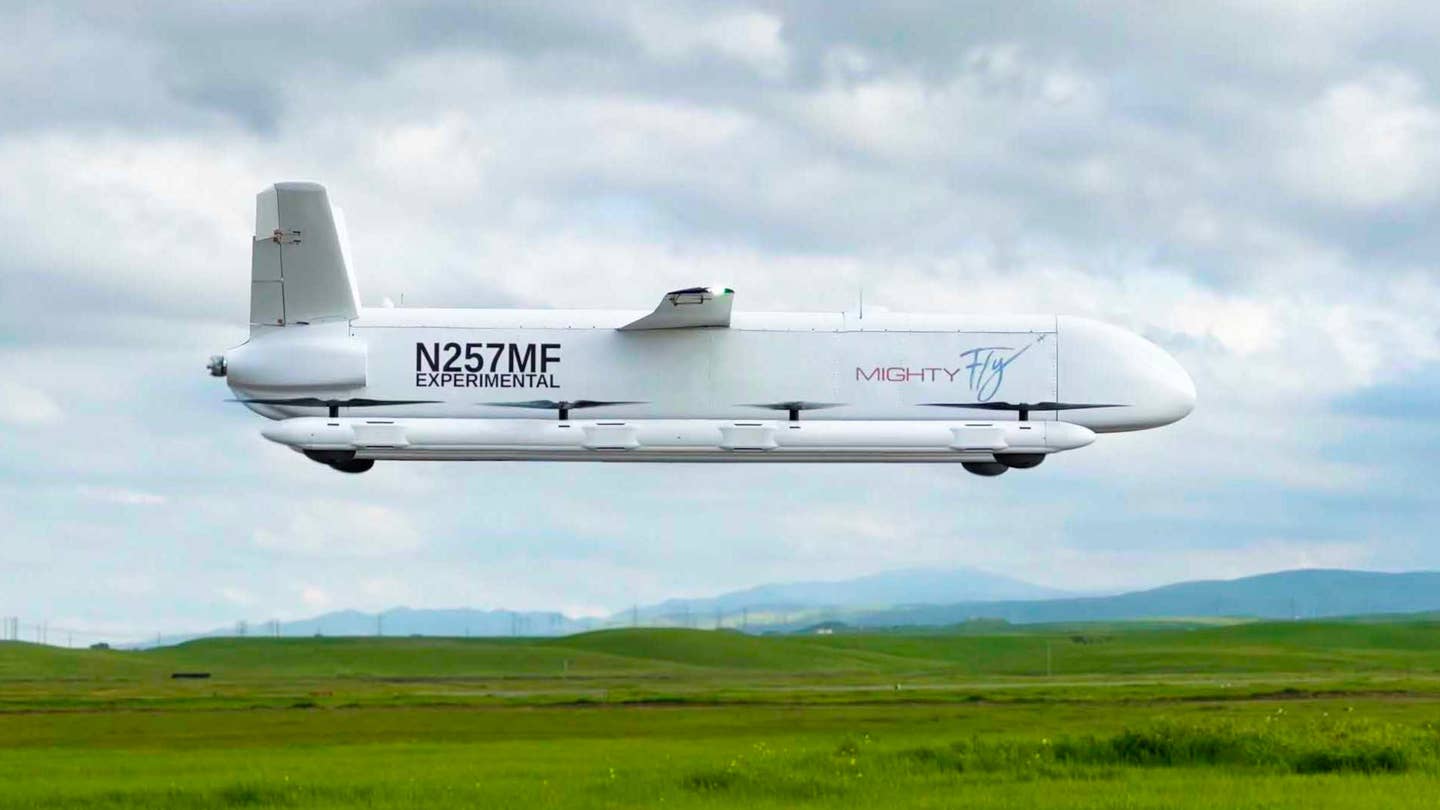MightyFly Obtains ‘Industry First’ FAA Flight Corridor Approval in California
The company says its 2024 Cento is the first large, self-flying, electric vertical takeoff and landing (eVTOL) cargo drone to receive the consent.

MightyFly’s third-generation Cento drone performs an autonomous hover flight in California in March 2023. [Courtesy: MightyFly]
A self-flying electric vertical takeoff and landing (eVTOL) drone for the cargo logistics industry has obtained a first-of-its-kind approval, according to its manufacturer.
California-based MightyFly this week announced what the company is calling an “industry first” FAA authorization, granting it permission to test its recently unveiled 2024 Cento within a flight corridor between New Jerusalem Airport (1Q4) and Byron Airport (C83) in California.
MightyFly says the approval, obtained in March, is the first for a large, self-flying cargo eVTOL in the U.S., with “large” denoting a weight greater than 55 pounds. According to the FAA, the company’s UAS has a maximum takeoff weight of 550 pounds. MightyFly in January received an FAA special airworthiness certificate (SAC) and certificate of waiver or authorization (COA) to establish the corridor.
“This route is designed to connect the existing operating areas around the airports while ensuring the UAS does not overfly the city of Tracy or impact Stockton [Metropolitan Airport], which is Class D airspace,” the FAA told FLYING. “MightyFly needed the new authorization to operate in the area, but they could have started testing inside the operating areas that were previously approved.”
The firm’s March approval, which it obtained via Freedom of Information Act (FOIA) request, includes a COA authorizing a flight corridor up to 5,000 feet agl between New Jerusalem and Byron airports. The COA opens the ability for the company to perform what it terms “A-to-B flights” within the corridor’s general aviation airspace, allowing it to test aircraft range, among other things.
Following ground testing at its headquarters and test site, MightyFly began flying the 2024 Cento at the corridor’s origin airport on March 4. In the span of two months, the company has completed more than 30 autonomous flights, or about one every two days.
Future testing will include A-to-B flights. Eventually, it will expand to additional use cases and markets, MightyFly says.
“This is a solid vote of confidence from the FAA in our work and our ability to perform safe autonomous flights in the general aviation airspace,” said Manal Habib, CEO of MightyFly. “We now look forward to demonstrating point-to-point delivery flights with our partners in this space.”
The authorization also contains a SAC that will allow MightyFly to test Cento’s beyond visual line of sight (BVLOS) capabilities, which are considered key for enabling drone delivery at scale.
BVLOS refers to the drone operator’s ability (or lack thereof) to visually monitor the aircraft in the sky. In lieu of a final BVLOS rule, the FAA awards these permissions to select companies via waiver or exemption. But for safety reasons most companies must keep their drones within view of the operator.
However, technologies such as detect and avoid and remote identification have the potential to replace human observers as they mature. MightyFly will test Cento’s detect and avoid systems and long-range command and control (C2) datalink communications while the self-flying drone is trailed by a chase airplane.
The SAC also authorizes MightyFly to begin point-to-point autonomous deliveries and proof of concept demonstrations with customers and partners. These will include deliveries of medical and pharmaceutical supplies, spare parts and manufacturing components, and consumer goods within the flight corridor.
Future demonstrations include several planned point-to-point autonomous cargo delivery flights in Michigan under a contract with the state’s Office of Future Mobility and Electrification. The company is also scheduled to demonstrate Cento’s ability to autonomously load, unload, and balance packages for the U.S. Air Force in 2025. These flights, MightyFly says, will mark its “entry into the expedited delivery market.”
The 2024 Cento, MightyFly’s third-generation aircraft, is designed for expedited or “just-in-time” deliveries. Potential customers include manufacturers, medical teams, first responders, retailers, and logistics, automotive, and oil and gas companies.
The third-generation drone is built to carry up to 100 pounds of cargo over 600 sm (521 nm), cruising at 150 mph (130 knots). Under full autonomy, it is expected to be able to land at a fulfillment center, receive packages, fly to a destination, unload its cargo, and take off for its next delivery.
MightyFly’s Autonomous Load Mastering System (ALMS) autonomously opens and closes the cargo bay door, secures packages in (or ejects them from) the cargo hold, and senses the payload’s weight and balance to determine its center of gravity. The company is working with the Air Force and its Air Mobility Command to develop ALMS.
Another key differentiator for the 2024 Cento is its flexibility. The drone can handle a variety of cargo contents, densities, loading orders, and tie-down positions. That means customers won’t need to standardize their packaging or order loading processes to accommodate it. The aircraft can carry refrigeration boxes, for example, which are often used in the healthcare industry to transport organ donations or blood bags.
Like this story? We think you'll also like the Future of FLYING newsletter sent every Thursday afternoon. Sign up now.

Sign-up for newsletters & special offers!
Get the latest FLYING stories & special offers delivered directly to your inbox






